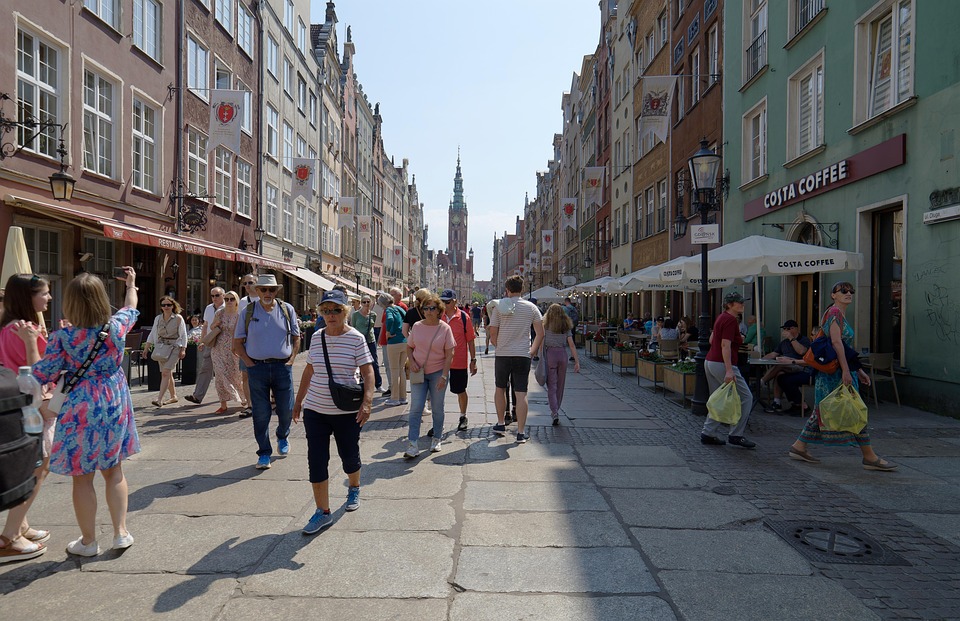Imagine you are a global brand in an ideal world (no tariffs, non-tariff barriers, etc.). When you look around the world you see that almost half of humanity is under the age of 30, and 69% of all people on the planet are within the 44-year mark. The median age of the world's population is a super youthful 31 (= half the population is below that and half above).
You have nothing to worry about then - it's clear you are targeting mainly the young. It's just that, let's face it, most of you are not a global brand, and certainly not in an ideal world. You move professionally in Europe and probably mostly in the Czech Republic.
And the situation here is very different. In the EU, only 47% of the population will fit into your 44 years, and the median age in the EU is 44.7.
And how are we in the Czech Republic? The median age is 43.5.
If we divide the Czech population by age into age subgroups, we get the following figures (as of the end of 2023, source CSO):
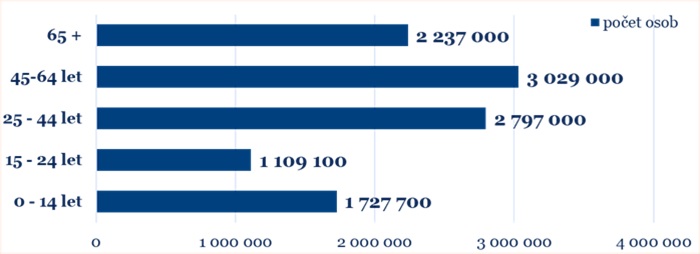 Source: CSO
Source: CSOWe have about 1.1 million young, fresh, cheerful generation (if we take this with children under 14 we get to 2.8 million). I think we can agree that these are the ones that marketing focuses on very intensely. The second marketing favourite group of Czechs is the 2.8 million people aged 25-44.
But the largest age group in the Czech Republic is people aged 45-64, which is more than three million, and it is quite often invisible from a marketing perspective. While younger Czechs have a lot of aspirations, even delusional ones, according to the ads, after the age of 45 there is a turning point. Probably even in marketers themselves (including those 45 ) the stereotype survives that at this age people switch to a "stick and scarf" lifestyle.
Yet all one has to do is look around. The era of the life- and work-worn forties and fifties is long past - and, dare we say, even outside the proverbial Prague. With a little effort, one can see that this age group is also living active lives full of dreams, wishes, plans and aspirations.
The aim of the WPP media project Czechs 45 is to use data to show that it simply does not make economic sense to neglect this target group. To clarify, by "45" in the text we mean the age group 45-64 and all data comes from mPanel, WPP Media's data source. For this article, we have already updated the data for 2025 (everything will be updated on the project website by the end of August).
Follow the money
If there is money and assets (mostly unencumbered by debt like mortgages) somewhere in Czech society, it is in the 45-64 age group.
Just look at the number of wage earners in the household and how many people in the household the money earned is for. If we compare Czechs aged 45-64 and those aged 25-44 we find that in terms of the number of earners in the household they are quite comparable groups. In both, 50% of households have two wage earners and 30% and 32% have one wage earner. But there is a catch. While only 39% of younger Czechs under 44 have two-person households, 55% of households in the 45-64 age group do.
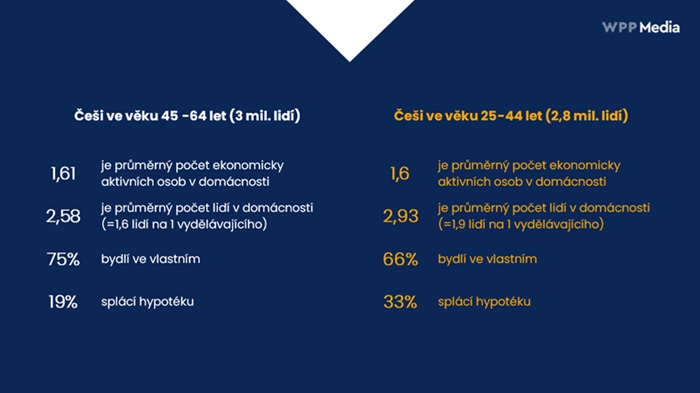 Source: mPanel, data source WPP Media
Source: mPanel, data source WPP MediaThus, on average, there are 1.61 economically active persons per household with Czechs aged 45-64, and the mean (median) number of people in the household is 2.58. For younger Czechs aged 25-44, the respective figures are 1.6 and 2.93.
So it doesn't take that much complex math to decipher that more mature Czechs have higher disposable incomes per person on average than younger ones. And we certainly won't discover America if we also point out that careers take time to build and salaries (mostly) increase with age and experience.
In addition, Czechs aged 45-64 are more likely to own their own home and are less burdened by debt.
Do you live under the idea that in middle age one resigns oneself to one's appearance?
Leaving aside the difference between the sexes, the difference between younger and more mature Czechs in their attitude to their own appearance or fashion is not dramatic. On the contrary, in some ways, the more mature Czechs lead the way and definitely want to maintain themselves! Moreover, it is good to see the data in context. You'll find that even younger Czechs are not big fancy freaks ..
And, for example, the lower scores for the attribute "It is important to me to be beautiful in the eyes of others" can hardly be explained by the fact that they no longer care what they look like. As one gets older, one simply comes to realize that others can kiss the back of one's head in some ways, however low they want to. Also, at a more mature age, people often have their own style and preferences and don't need to jump on every "micro-trend" that pops up. But all of this doesn't mean they don't want to look good and take care of themselves!
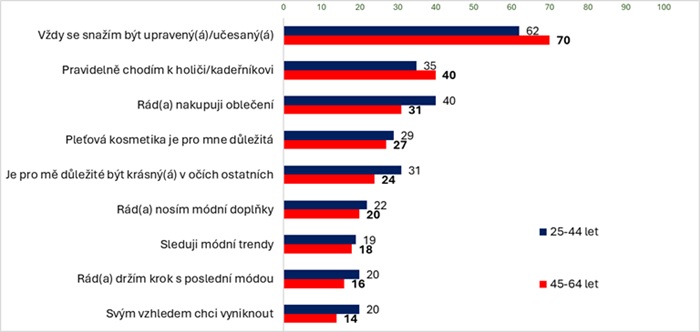 Source: mPanel, data source WPP Media
Source: mPanel, data source WPP MediaNo 50-year-old is 50-year-old: segments of the Czech population aged 45-64
The three million Czechs aged 45-64 are certainly not a homogeneous audience. There are different ways to segment such a number of people. According to hard socio-economic data or perhaps according to lifestyle statements. For our project, we chose the second option because it best shows the difference in approach to life between the different segments.
We do not have space here to present in detail all 6 segments we work with in the project. But in short, age or gender does not determine the way you mature after 40. Some will be mentally 15 until they are 90 before they forget who they are, and others will have been born as resigned, resigned to everything and wanting for nothing retirees. And please don't hold that against retirees, there are big differences between them too - we have data on that too.
So here is a very brief overview of the segments of mature Czechs.
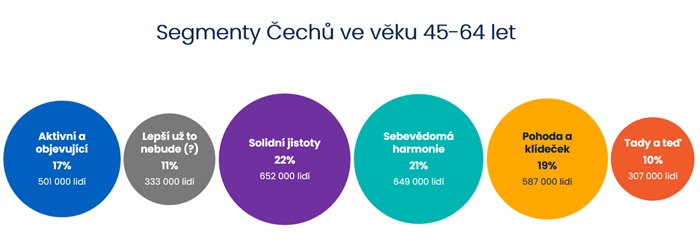 Source: GroupM_Czechs 45-64_2024
Source: GroupM_Czechs 45-64_2024Active and exploring (17%), 67% are women
They certainly aren't going to worry about the fact that they are getting up there in calendar years and see no reason why they should stop being interested in the world, trying new things or suffering from FOMO on social media because of it. Just young at heart from start to finish.
And just a side note: before you start drawing conclusions that there are few Active and Explorers, so Czechs 45 are unattractive oldsters after all, try to guess how strong this segment is among younger Czechs 25-44 ... among the latter it's only 23%.
It doesn't get any better than this (?), or a lacklustre average (11%), 69% are men
This group is characterised by being unremarkable - except for one thing, and that is marital status / cohabitation. A full 40% are and always have been single - for the second "most single" segment in the ranking, only 16% are single! And 53% live alone (for the second "most single" segment, it's 18%!).
They are the least satisfied with their lives, their standard of living, their jobs. Whether it follows that partner life and children bring happiness, we'll leave that up to you.
And why won't Better off come with a question mark? It's not a complete resignation, it's just that somehow life isn't going the way it (should) right now.
Solid security (22%), 68% men
They've achieved something, are secure (highest proportion of AB groups: 42%) and fairly educated. They have a relatively conservative approach to life and the world, in all respects. There is a prevailing confidence of 50-year-old secure men/women who know how the world works.
Self-confident harmony (21%), 37% women
The most educated, 2nd most affluent and predominantly female segment - and defying stereotypes about women's low self-esteem, here you will find the highest levels of self-confidence across all segments.
They have a strong preference for order, system, control, order. Some kind of reckless spontaneous actions usually have no place here. On the other hand, they like life, fun, society, culture. They are very keen on organic and eco-friendly things and very, very keen on a healthy lifestyle.
Easy-going and easy-going (19%), male/female 50/50
Truth be told, this is a segment that has the characteristics that a large number of marketers probably associate with more mature Czechs. The coolness and coolness in the name refer to the setting of this segment, which is, however, happy in this state. They don't have any great aspirations anymore and they don't mind.
They like their peace and quiet. The main thing is that everything should be nice Czech, our little klídeček and a bit of the "traditional" world. And it is this segment where you will find by far the most Eurosceptics.
Carpe Diem (here and now) (10%), men 56%
This is the poorest segment, but it definitely has aspirations for a higher lifestyle. They are not particularly satisfied with their current life, and even less satisfied with their standard of living (both the least of all). On the other hand, they are quite spontaneous, carefree to frivolous. They can't resist shopping, marketing and novelties, even though they often don't come up with the money and go into debt.
Czechs 45 are not a homogeneous mass, but to be honest, it will be enough to start taking note of this group of Czechs. In the next installment, we will focus on the Czechs 45 as consumers, what their media habits are and how to influence them.
Petr Tomáš, Consumer Research Skillhead, WPP Media
Source: mediaguru.cz

